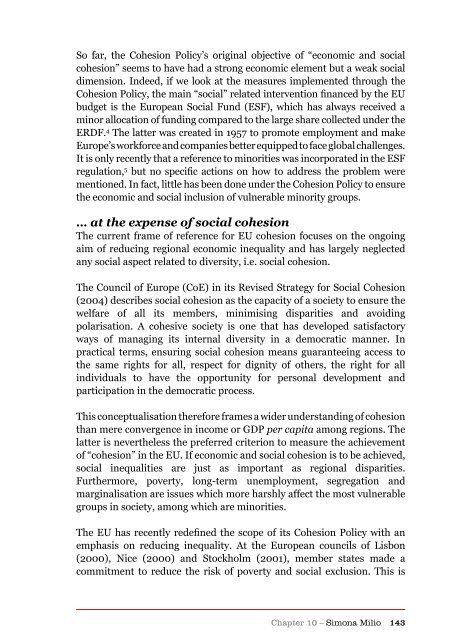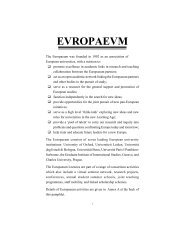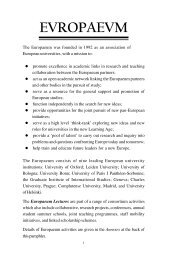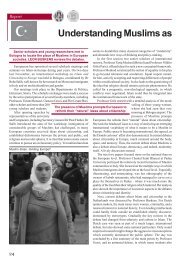Authors Iain Begg | Gabriel Glöckler | Anke Hassel ... - The Europaeum
Authors Iain Begg | Gabriel Glöckler | Anke Hassel ... - The Europaeum
Authors Iain Begg | Gabriel Glöckler | Anke Hassel ... - The Europaeum
Create successful ePaper yourself
Turn your PDF publications into a flip-book with our unique Google optimized e-Paper software.
So far, the Cohesion Policy’s original objective of “economic and social<br />
cohesion” seems to have had a strong economic element but a weak social<br />
dimension. Indeed, if we look at the measures implemented through the<br />
Cohesion Policy, the main “social” related intervention financed by the EU<br />
budget is the European Social Fund (ESF), which has always received a<br />
minor allocation of funding compared to the large share collected under the<br />
ERDF. 4 <strong>The</strong> latter was created in 1957 to promote employment and make<br />
Europe’s workforce and companies better equipped to face global challenges.<br />
It is only recently that a reference to minorities was incorporated in the ESF<br />
regulation, 5 but no specific actions on how to address the problem were<br />
mentioned. In fact, little has been done under the Cohesion Policy to ensure<br />
the economic and social inclusion of vulnerable minority groups.<br />
… at the expense of social cohesion<br />
<strong>The</strong> current frame of reference for EU cohesion focuses on the ongoing<br />
aim of reducing regional economic inequality and has largely neglected<br />
any social aspect related to diversity, i.e. social cohesion.<br />
<strong>The</strong> Council of Europe (CoE) in its Revised Strategy for Social Cohesion<br />
(2004) describes social cohesion as the capacity of a society to ensure the<br />
welfare of all its members, minimising disparities and avoiding<br />
polarisation. A cohesive society is one that has developed satisfactory<br />
ways of managing its internal diversity in a democratic manner. In<br />
practical terms, ensuring social cohesion means guaranteeing access to<br />
the same rights for all, respect for dignity of others, the right for all<br />
individuals to have the opportunity for personal development and<br />
participation in the democratic process.<br />
This conceptualisation therefore frames a wider understanding of cohesion<br />
than mere convergence in income or GDP per capita among regions. <strong>The</strong><br />
latter is nevertheless the preferred criterion to measure the achievement<br />
of “cohesion” in the EU. If economic and social cohesion is to be achieved,<br />
social inequalities are just as important as regional disparities.<br />
Furthermore, poverty, long-term unemployment, segregation and<br />
marginalisation are issues which more harshly affect the most vulnerable<br />
groups in society, among which are minorities.<br />
<strong>The</strong> EU has recently redefined the scope of its Cohesion Policy with an<br />
emphasis on reducing inequality. At the European councils of Lisbon<br />
(2000), Nice (2000) and Stockholm (2001), member states made a<br />
commitment to reduce the risk of poverty and social exclusion. This is<br />
Chapter 10 – Simona Milio 143

















